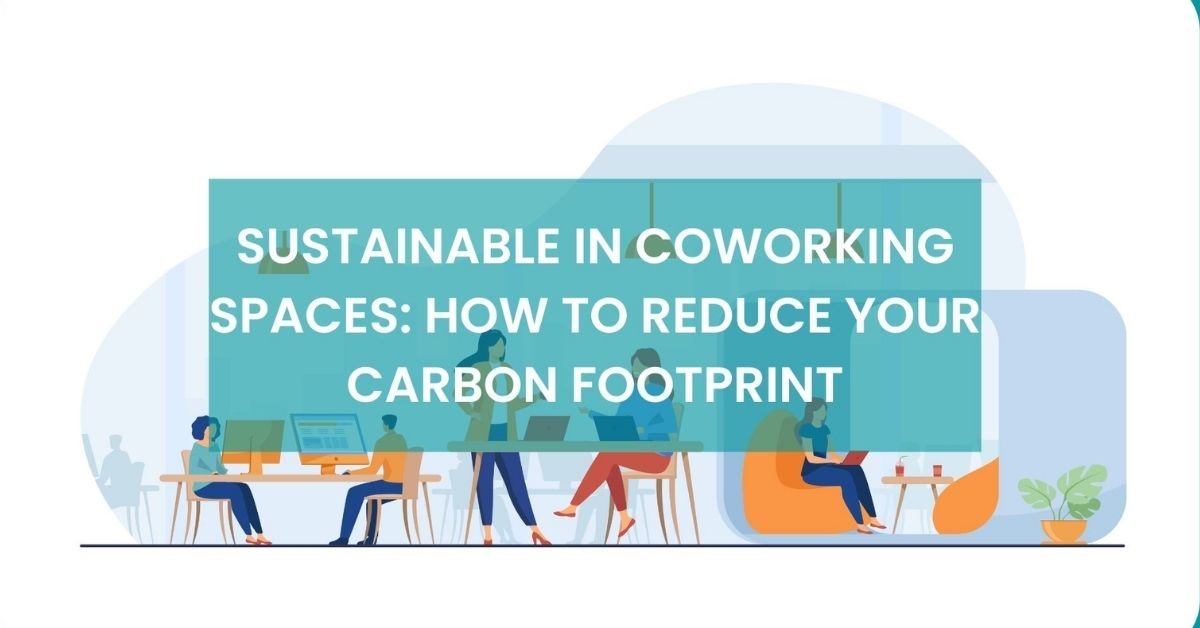
Are you looking for ways to make your Coworking Spaces more environmentally friendly? As the world becomes increasingly aware of our impact on the planet, we all must take steps toward reducing our carbon footprint. In this blog post, we’ll explore a range of innovative ideas and strategies for boosting sustainability and efficiency in your workspace. From energy-efficient lighting to eco-friendly office supplies, there are plenty of simple yet effective solutions that can help reduce your environmental impact while creating a more comfortable and productive working environment. So let’s dive in and discover how you can do your part for the planet while still maintaining a successful coworking business!
Are you tired of feeling guilty about your carbon footprint in the workplace? As a coworking space user, it can be challenging to maintain sustainable practices and reduce our environmental impact. However, with innovative ideas and small changes in our daily routine, we can make a significant impact on the environment while improving efficiency and saving costs. In this blog post, we will explore some exciting ways to reduce your carbon footprint in coworking spaces and contribute towards a more sustainable future. Let’s get started!

Welcome to the world of coworking spaces – a hub for creativity, collaboration, and community. With their open-plan layouts, flexible working options, and vibrant atmospheres, it’s no wonder that more and more people are choosing to work in these shared offices. But with great power comes great responsibility – we’re talking about your carbon footprint! As coworking spaces continue to grow in popularity, we must explore new ways to reduce our impact on the environment. In this blog post, we’ll be sharing innovative ideas for sustainability and efficiency so you can take steps toward a greener workspace. So grab a coffee (in your reusable mug of course), sit back, and let’s get started!
Introduction to Carbon Footprint
A carbon footprint is the total amount of greenhouse gases emitted by an individual, company, event, or product throughout its life cycle. The main sources of emissions from coworking spaces are electricity consumption, natural gas consumption, and transportation.
There are two types of carbon footprints: direct and indirect. Direct emissions come from sources that we can control, like turning off the lights when we leave a room. Indirect emissions come from upstream sources that we can’t control like the power plant generating electricity for our office space. The majority of our carbon footprints come from indirect emissions.
To Reduce Your Carbon Footprint in Coworking Spaces, There are a Few Things You Can Do:
1. Use less energy: Turn off the lights when you leave a room, unplug devices when they’re not in use, and take the stairs instead of the elevator.
2. Educate yourself and others about climate change: The more we know about the issue, the more likely we are to take action. Encourage your coworkers to learn about climate change and what they can do to help reduce its impact.
3. Advocate for sustainable policies at your coworking space.
What is a Coworking Spaces?
A coworking space is a shared office environment where individuals from different organizations can come together to work. It’s a place where you can have your desk, but also access communal areas and resources, like meeting rooms and printers/copiers. The benefits of coworking spaces are that they can save you money on overhead costs, provide a more flexible working environment, and foster a sense of community and collaboration.

However, with the growing popularity of coworking spaces, there is an increased need for sustainability and efficiency to reduce the environmental impact of these workplaces. Here are some innovative ideas for reducing your carbon footprint in a coworking space:
1. Implement a recycling program: Many coworking spaces already have recycling bins, but not all members use them. Make it easy for everyone by having clearly labeled bins for paper, plastic, and aluminum. Encourage members to recycle by providing incentives, like coupons or free coffee.
2. Use energy-efficient appliances: If your coworking space has a kitchen, make sure that all appliances are energy-efficient. This includes the fridge, stove, oven, dishwasher, and any other small appliances that members might use. Energy-efficient appliances use less electricity and water, which will help reduce your carbon footprint.
3. Encourage sustainable commuting: Many people who work in coworking spaces live close by, which makes biking or walking to work a viable option. Provide bike racks or storage
Benefits of Reducing your Carbon Footprint in Coworking Spaces
When it comes to reducing your carbon footprint, coworking spaces are a great option. Not only do they promote sustainability and efficiency, but they also provide numerous benefits for businesses and employees alike. Here are just a few of the many reasons why you should consider reducing your carbon footprint in coworking spaces:
1. Save money on energy costs: One of the biggest benefits of reducing your carbon footprint is that it can help you save money on energy costs. By making your workplace more energy-efficient, you can reduce your monthly utility bills and free up more funds for other business expenses.
2. Create a healthier workplace: Another benefit of reducing your carbon footprint is that it can create a healthier workplace environment. By improving the air quality and temperature control in your office, you can reduce the risk of sick days and improve employee productivity.
3. Attract new talent: In today’s competitive job market, businesses need to stand out from the crowd to attract top talent. Reducing your carbon footprint is a great way to show that you’re an environmentally responsible company that cares about its impact on the planet. This can give you a major leg up in the recruitment process.
4. Enhance your brand image: In addition to attracting new talent, reducing your carbon footprint can also enhance your brand image and reputation among consumers. With increasing public concern about environmental issues, consumers are increasingly likely to patronize businesses that are making an effort to be more sustainable.
Simple Tips for Reducing Carbon Emissions
As coworking spaces become more popular, it’s important to consider the environmental impact of these shared work environments. Here are some simple tips for reducing carbon emissions in coworking spaces:
1. Encourage carpooling or public transportation: By encouraging employees to carpool or use public transportation to get to and from work, you can significantly reduce your carbon footprint.
2. Implement green office practices: There are many simple ways to make your office more sustainable, such as using energy-efficient lighting, recycling and composting, and using less paper.
3. Educate employees on sustainability: One of the best ways to reduce your carbon footprint is to educate your employees on sustainable practices. Host workshops or lunch-and-learns on topics like green commuting options, energy efficiency, and waste reduction.
4. Purchase green power: If your building doesn’t have solar panels or wind turbines, you can still support renewable energy by purchasing green power from your utility company.
5. Advocate for policy change: Finally, one of the most impactful things you can do to reduce your carbon footprint is to advocate for policy change at the local, state, and federal levels. Call or write your representatives and let them know that you support policies that will help fight climate change.
Innovative Ideas for Sustainability and Efficiency
The coworking industry has been on the rise in recent years, and with good reason. Coworking spaces provide a flexible and affordable way to work, while also promoting collaboration and community. However, as the industry continues to grow, it’s important to consider the environmental impact of coworking spaces.
There are several ways to make coworking spaces more sustainable and efficient, from simple changes like using recycled materials to more innovative ideas like using solar power. Here are a few ideas to get you started:
1. Use recycled materials: Recycled materials can be used in a variety of ways in coworking spaces. For example, recycled paper can be used for printer paper or notepads, while recycled plastic can be used for furniture or other items.
2. Use energy-efficient lighting: Lighting is one of the biggest energy users in any space. Switching to energy-efficient lightings, such as LED bulbs, can help reduce your carbon footprint.
3. Use solar power: Solar power is a renewable resource that can be used to power all sorts of things, from lights to computers. Installing solar panels in your coworking space can help offset your energy use and reduce your carbon footprint.
4. Implement green office practices: There are many simple things you can do to make your office more sustainable, such as recycling paper and ink cartridges, printing double-sided documents, and using reusable cups and plates. Every little bit helps Long-Term Strategies for Reducing Your Carbon Footprint in Coworking Spaces
Many businesses are looking for ways to reduce their carbon footprints and become more sustainable. Coworking spaces can be a great way to promote sustainability and efficiency in the workplace. Here are some long-term strategies for reducing your carbon footprint in coworking spaces:
1. Use renewable energy sources: Renewable energy sources such as solar and wind power can help reduce your carbon footprint. Many coworking spaces are already using renewable energy sources, so you can join them in their efforts to be more sustainable.
2. Educate employees about sustainability: Employees need to be aware of the importance of sustainability and how they can help contribute to it. You can educate employees about sustainability by hosting workshops, creating educational materials, or implementing green policies in your coworking space.
3. Encourage green practices: You can encourage employees to adopt green practices in their everyday lives by providing incentives, such as discounts on eco-friendly products or prizes for employees who reduce their carbon footprints.
4. Invest in energy-efficient technologies: Energy-efficient technologies such as LED lighting and energy-efficient appliances can help reduce your carbon footprint while also saving you money on your energy bills. Many coworking spaces in Noida have already invested in these technologies, so you can follow their lead.
5. Reduce waste: One of the best ways to reduce your carbon footprint is to reduce the amount of waste you generate. You can do this by implementing recycling and composting programs in your coworking space.

Conclusion
Reducing our carbon footprint in Coworking spaces is essential for achieving sustainability and efficiency. By implementing innovative ideas such as investing in green technology, recycling, using renewable sources of energy, and reducing waste, we can work towards creating a healthier environment for everyone. We hope that this article has provided you with some useful tips on how to reduce your carbon footprint in coworking spaces for a more sustainable future.







Your article helped me a lot, is there any more related content? Thanks!